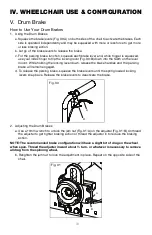
41
V. MAINTENANCE AND CARE
A. Maintenance Table
Regular and routine maintenance will extend the life of your wheelchair while improving its
performance. Wheelchair repairs, the replacement of parts and any maintenance check that you
are not comfortable performing should be done by an authorized supplier. Only use Ki Mobility
approved parts when replacing components.
Do not use petroleum-based solvents, degreasers or dewatering agents (including but not
limited to automotive cleaners, alcohols or WD-40). Damage to components, bearings or
finishes may occur.
Check
Weekly Monthly Annually
Check the tire inflation levels and inflate as needed. The correct inflation levels
are found on the tire.
√
Check wheel lock engagement and disengagement. Tire pressure changes and
tire wear will require the wheel locks to be adjusted. Wheel lock adjustment
instructions can be found in the Wheel Locks section of this manual.
√
Check the axle sleeves and axle plates to ensure the axle sleeve nuts are tight.
√
Check that quick release axles engage and disengage properly.
√
Check that caster wheels, anti-tip wheels and rear wheels spin freely. Cleaning
or replacement parts may be needed if there are any issues.
√
Clean area around the caster housing and bearings. This is a common location
for hair build up.
√
Clean your wheelchair. See the Cleaning section in this manual for instructions.
√
Check the rear tires, anti-tip wheels and the caster wheels for wear spots or
damage. Replace immediately if needed.
√
Check handrims to ensure they are secure and not damaged.
√
Check that the hand grips do not rotate or pull off. Replace if needed.
√
Check armrest receivers for loose or missing fasteners and check they are
secure, adjusted properly and maintain position.
√
Wipe the rotary frame glide surfaces with a damp cloth.
√
Test tilt cable function and visually inspect the cable for correct routing (See
the Tilt Mechanism section), harsh bends and kinks.
√
Confirm all cables and handles release and return properly if present.
√
Check that anti-tips are level and functional.
√
Visually inspect the roller bearings for signs of wear or damage.
√
Inspect the frame(s) and anti-tips for deformities, defects, cracks, dimples or
bends. These could be signs of fatigue in the wheelchair which could result in a
failure. Discontinue use of the wheelchair immediately and contact an
authorized supplier.
√
Check upholstery for signs of wear, fraying or holes. Replace upholstery
immediately if needed.
√
Check arm pads, cushions and back rest for damage, rips or tears.
√
Check wheels for any loose, broke or bent spokes. Replace immediately if
needed.
√
Check that all fasteners are tight. Unless otherwise noted, fasteners should be
tightened to 40 in./lbs (4.51 N*m).
√
Verify the wheelchair rolls easily and straight.
√
Have the wheelchair checked and adjusted by a qualified technician at your
authorized supplier.
√
Содержание Focus CR
Страница 1: ...2021 03 11...
Страница 47: ...2021 03 11...
Страница 97: ......
Страница 98: ......
Страница 99: ......
Страница 100: ...Ki Mobility 5201 Woodward Drive Stevens Point Wisconsin 54481 715 254 0991 www kimobility com DCN0255 0...
















































